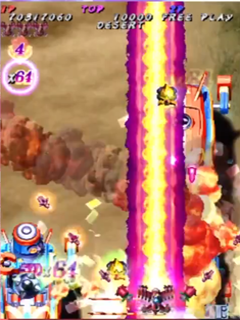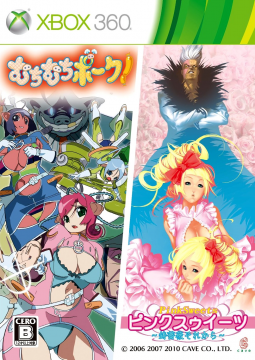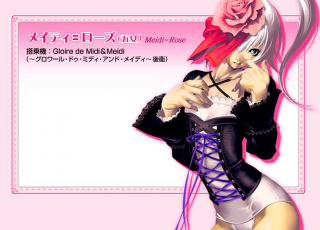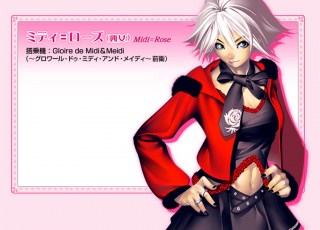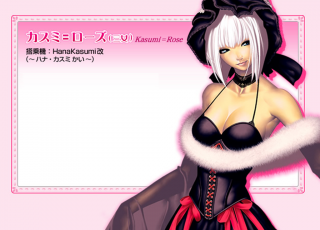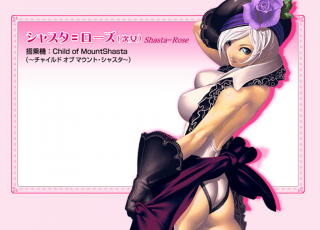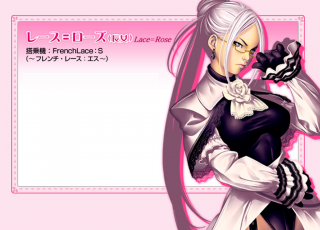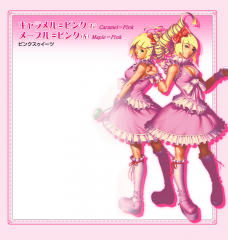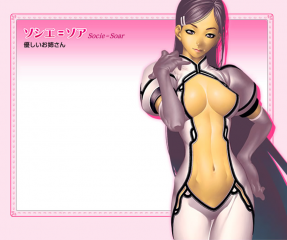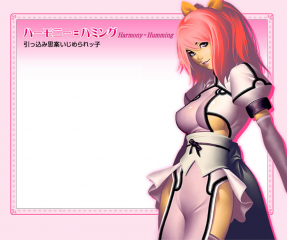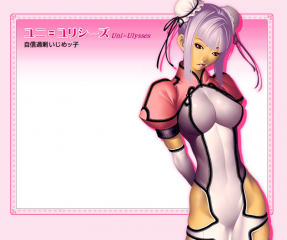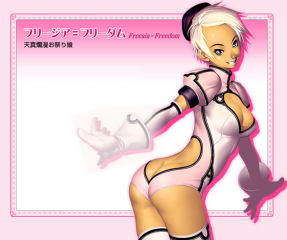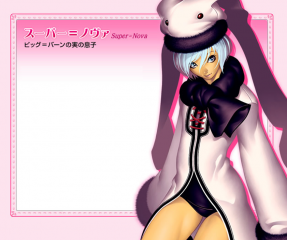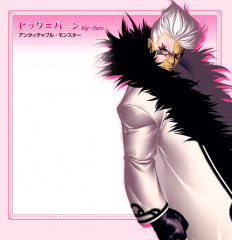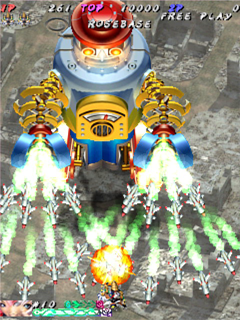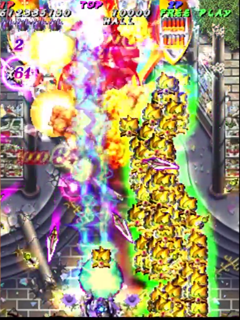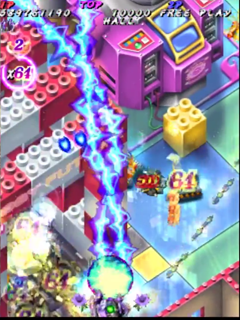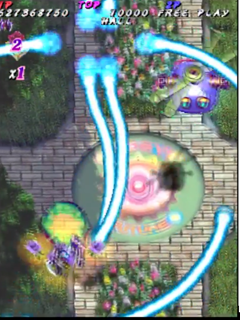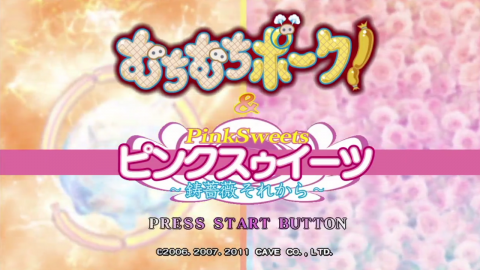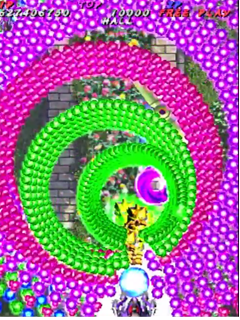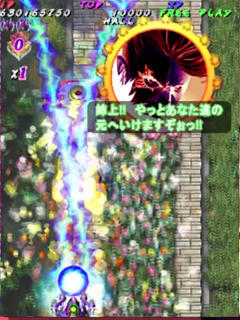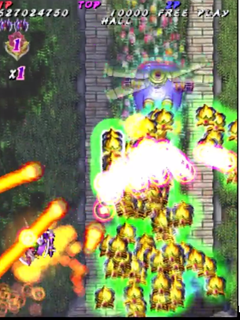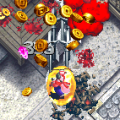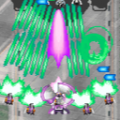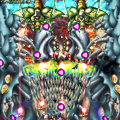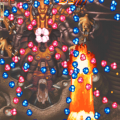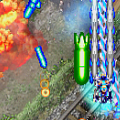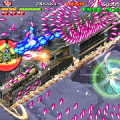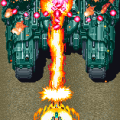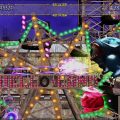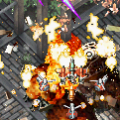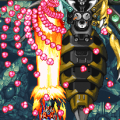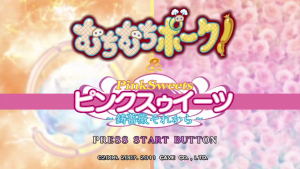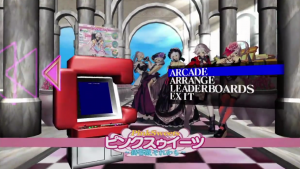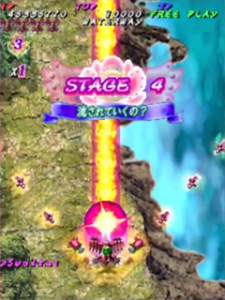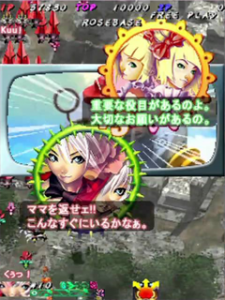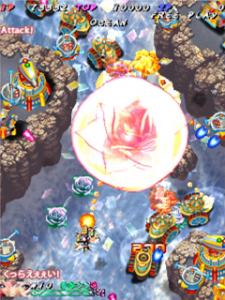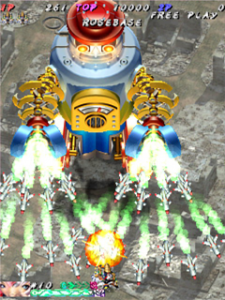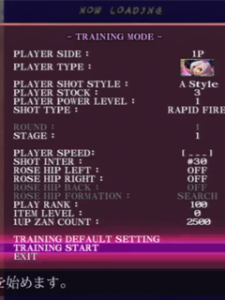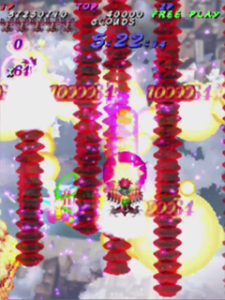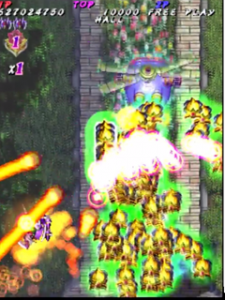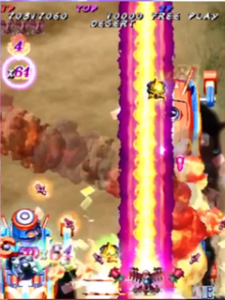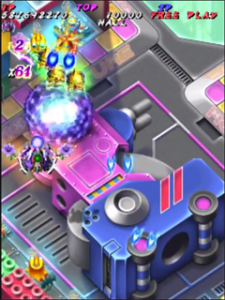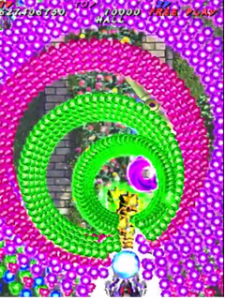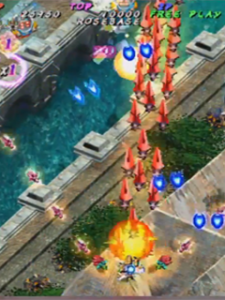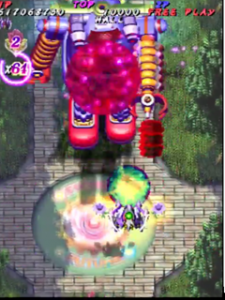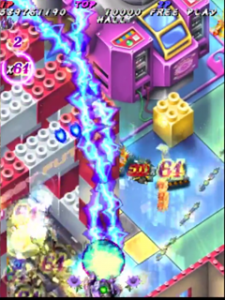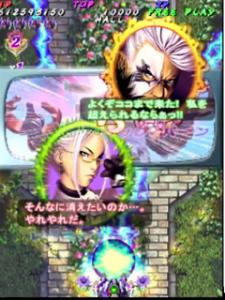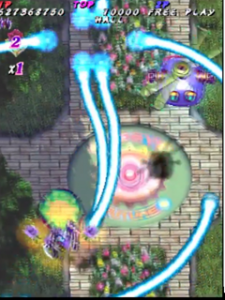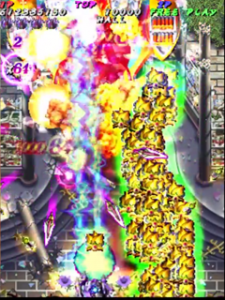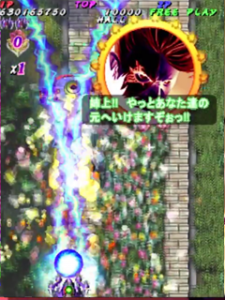The release of Ibara was met with a rather mixed reception. Fans of Battle Garegga loved it, but most of the Cave fan base, and the public at large, were turned off by the punishing, rank based shoot-em-up. Still, Ibara would see a sequel released roughly a year later. The sequel, titled Pink Sweets ~Ibara Sorekara~, would take the elements of Ibara that turned many people away from the game, and outright remove them from the sequel. Things like rank management, bomb fragments, multiple option types, and even score based extends were removed from the game entirely…with nothing added in to replace them. This leaves us with an unbalanced game that is very, very, hard to beat on a single credit without using a deliberately placed secret (not a glitch). And, that secret is only available in the first three revisions of the arcade version! The most striking change from Ibara to Pink Sweets is the art direction. Ibara was a gritty industrialist steampunk world, and its designs fit well into this setting. Pink Sweets keeps the same world, but throws in colorful enemies based on the old tin robots from the 1950s and ’60s, and they don’t blend in at all. It’s really jarring why they went this direction, and it never manages to blend itself into the existing world.
Story
At the end of Ibara the Negotiators Bond and Dyne were able to successfully defeat Rose Garden’s five guardians, and apprehend the group’s leader Dr. Teresa Rose, successfully ending the invasion. Dr. Teresa would go on to face judgment at the Western European Union. Meanwhile, in a dark room in the middle of the night, two girls, dressed in pink were talking to an enormous man sitting at a table. “My arms have gotten heavier recently” one stated. “My foot has gone dull recently.” said the other. “Hmm… it appears my skills aren’t enough.” said the man, “I know of an incredibly gifted prosthetics engineer in Edelweiss. We’ll have her take a look.” The next morning the man awoke to a terrible sight, the headline of his newspaper read that Teresa Rose would be sentenced to be exiled on an island in the Atlantic Ocean. But this was perfect for Big Burn, who easily arranged for her to be released into his personal care; Dr. Teresa was his wife, after all. With no hope left, Dr. Teresa quietly did as he was told, creating four “maids” at his command. Suddenly the minions of Big Burn are in a panic, informing him that the Western Union peacekeeping headquarters has been raided. The small combat group appeared to be wearing the coat of arms of the “Rose Garden”. Dr. Teresa’s eyes lit up once again, “My daughters…are still alive!” Far off in the distance, four ships rose up over the horizon.
Protagonists
Meidi Rose
Co-Pilot of the Glorie de Midi & Meidi, equal in speed to Shasta’s ship. Using the Rapid Shot shoots varying streams of bullets from the front and back of the ship. Their Rose Cracker is similar to the Type D bomb from Ibara. Weakest ship type overall.
Midi Rose
Co-Pilot of the Glorie de Midi & Meidi, equal in speed to Shasta’s ship. Using the Wide shot Shoots up to 5-directions in front, similar to Dyne’s ship from Ibara. Due to poor damage output, their ship can barely get any points.
Kasumi Rose
Pilots the Hana Kasumi ship, and is slower than Meidi & Midi and Shasta’s ships. Using the Rapid shot unleashes a barrage of missiles in front of her. Her Wide shot fires homing missiles that seek out enemies. Her Rose Cracker is similar to the Type D bomb from Ibara. Great for beginners.
Shasta Rose
Pilots the Child of Mount Shasta, which is faster than Kasumi and Lace’s ships. Her Rapid Shot fires laser beams in front of her, and her Wide Shot allows her laser to alter the angle of her laser. Her Rose Cracker shoots out a massive laser, creating a line vertical to her position when fired. Shasta does trouble surviving if cornered.
Antagonists
Caramel Pink
Is never seen without her sister. Refers to Big Burn as her father. Caramel Pink Likes the color pink, and those who like pink. While she may look human, she is actually an artificial life form created by Big Burn. Since the kidnapping of Dr. Teresa, her body’s quality has improved dramatically.
Maple Pink
Is never seen without her sister. Refers to Big Burn as her father. Maple Pink also hates stinky things. Like her sister, Maple is an actually artificial life form created by Big Burn. Since the kidnapping of Dr. Teresa, her body’s quality has improved dramatically.
Socie Soar
The first maid of Big Burn. A beautiful woman, who always seems to be smiling. Sochie posses a kind and sociable personality that doesn’t seem to care for the finer things in life. As such, she can be a little rough around the edges at times…Regardless, she is the only maid that Big Burn finds reliable. There are rumors that this is all just a front, and her real goal is to usurp Big Burn, but the truth is unknown.
Harmony Humming
The second maid of Big Burn, she tends not to appear unless needed. A quiet girl, who acts carefully and diligent in all things. She is also very cooperative and attentive to the needs of others. She believes that Uni has always had a longing for strength.
Uni Ulysses
The third maid of Big Burn. She is excessively self-confident in her dexterity and excellent tactical analysis skills, but lacks patience and perseverance. She believes that advancing slowly and carefully is something suited for the weak. She feels that “prettiness” and “longing” are not for her.
Freesia Freedom
The fourth maid of Big Burn is also the lively evil daughter of love. She tends to do things at her own pace, and always keeps her emotions straight. Freesia recklessly assaults the Rose Garden, as she felt that Big Burn’s orders were too absurd, and that this way would be more fun. She hates being around children, or anything that even looks like a child. Therefore, it’s no surprise she hates Super Nova.
Super Nova
Loves and respects her father, Big Burn from the bottom of her heart. She does not know who her mother is, and has no interest in finding out. All she cares about is her father’s happiness. While she doesn’t realize it, she’s actually quite a spoiled child, and is currently on bad terms with Freesia.
Big Burn
A mysterious man, whose real name is unknown. Big Burn is one of Edelweiss’ leading businessman, and his contacts and financial power allow him to manipulate the Western European Union. His face is partially covered by a mask, and it is said that no one knows what lies beneath it. In fact, those who even dare to touch it are no longer heard from soon after. Kidnapped his ex-wife, Dr. Teresa and is forcing her to create a beautiful family with him.
Gameplay
As is tradition in Yagawa’s games, Pink Sweets contains alternate gameplay modes than just the standard Arcade mode, which consists of seven stages. These additional modes are accessed on the title screen, after putting a credit into the machine. Holding up on the joystick and pressing start will trigger Harder mode, where enemies release suicide bullets when destroyed, and more bullets overall; but, both the player’s ship and enemy’s bullets have smaller hit boxes in Harder mode. Holding the joystick in the down direction will activate Extended mode, which guarantees entry into Pink Sweets‘ hidden second loop. The third hidden game mode is Score Attack, and is accessed by holding down the A and B buttons when starting the game. In Score Attack, the game begins in Stage 6, with a 5 minute time limit. The goal of this mode is to gain as many points as possible within the time limit, which is extended by one minute every one million points. The “standard” version of Pink Sweets is the third revision, which will give players infinite lives while in Score Attack mode; however, other revisions of the game may only give players a total of three lives in Score Attack mode.
There is also a “Special Ver.” of the game, triggered via a DIP switch. Special Ver. enables players to start the game from any stage (though they are mislabeled), or even play a special Boss Rush mode of the game. But most importantly, when holding the B button at the title screen, players can enable a number of different hit boxes, allowing them to know exactly what can and can’t hurt them. Finally, there is a secret command that can only be executed during play. By pressing up, up, down, down, left, right, left, right, A, B, Start (seem familiar?) during gameplay, players can instantly quit the game, and be taken to the high score table. Note that the player’s score will not be recorded, even if the player achieved a high score through this method.
Like its predecessor, Ibara, Pink Sweets is also a two button game. Pressing the A button fires the ship’s basic shot, and holding the button down will automatically fire the Shot. The B button controls the ship’s options. Holding the B button down will cause the ship’s options to fire, while tapping the B button will change the options formation. The standard formations are Front, Wide, Back, Reverse, and Turn, with a secret Search option available via powerup. Pressing the A and B buttons together will increase or decrease the ships speed by one level. There are four levels of speed altogether. Replacing the bombs from Ibara is the new Rose Cracker system. The Rose Cracker acts very similarly to the bomb system in Summer Carnival ’92: Recca (also programmed by Yagawa) does. In Pink Sweets, The Rose Cracker automatically charges whenever the A button is not being pressed, and is fully charged after 3 seconds. When the Rose Cracker is fully charged, the player will gain an aura shield in front of them, which damages enemies and absorbs Type-1 bullets. Pressing the A button when the Rose Cracker is fully charged will fire it (effects are different for each character), destroying any and all types of bullets inside of it, as well as causing heavy damage to enemies.
In the previous paragraph it was mentioned that Type-1 bullets are absorbable by the aura shield of the Rose Cracker. In Pink Sweets, there are a total of three types of bullets, and four types of enemies. Type-1 bullets are absorbable with the shield, but cannot be destroyed with the shot. Type-2 bullets cannot be absorbed, and they cannot be destroyed with the shot. Type-3 bullets also cannot be absorbed by the aura-shield, but they can be destroyed with the standard shot. Again, firing the Rose Cracker will destroy any bullet it touches, regardless of type. The four different enemy types are rather simple to explain. Type-1 and Type-2 enemies are both airborne enemies, with Type-2 being any airborne enemy that has more than 1 hp. All ground enemies are Type-3, and all Mid-Bosses and Bosses are Type-4. The different types serve two purposes, the first being item drops, as only certain types of items drop from certain enemies, and the second being point value, as enemies will give 10x their normal point value if destroyed in a certain way. The specific methods of disposal are different for each type of enemy, making memorization of each type extremely important. That said, it’s even more important to remember that anything destroyed by the Rose Hips (options) will award the player zero points, to reduce the chance of this happening, it is best to have them in the Back formation during boss battles. The Rose Hips do have the ability to block Type-1 bullets like the Rose Cracker shield, making them serve as a decent defensive option.
Just like in Ibara, each character/ship in Pink Sweets possesses four different shot variations, which are selected via specific button combinations when selecting a character. There is a brief explanation of each character’s main shot and what it does in their character description above. For a more detailed explanation of how each shot type acts for each type for every character, please visit the “Pink Sweets Basics” link in the Links section below, as it’s just too much information and wouldn’t make sense in this format. When starting a game, players start with what is known as the “Basic Shot”, and is only used when they have collected zero power- up items. Collecting the Rapid Shot power-up causes the ship to fire in a more concentrated manner, usually towards the front of the ship, while the Wide Shot will fire the same amount as the Rapid Shot, just over a wider spread. What’s nice about Pink Sweets is that collecting a Power-Up item increases both Rapid and Wide Shots, and can be powered-up three times. Players also can collect options (called Rose Hips), but there are only the one shot type, and players can only have two of them at once.
The Shot and Rose Hip power-up items appear after every eight Type-1 enemies are destroyed, or after every one Type-2 enemy is destroyed. Type-3 enemies also drop an item when destroyed, but it will always be a rose point item. The items that drop from Type-1 and Type-2 enemies follow a specific order, and it repeats every eight items, so it’s easy to know what item is coming up next. The initial starting item order is Power-Up, Medal, Rapid Shot, Medal, Wide Shot, Medal, Rose Hip, Medal, after which it repeats from the first item. This is the starting item order, as the next item remains the next item even after the game is over, or quitting the game. The only way to reset the item order back to the starting order is by turning the PCB off.
Now, there are also some hidden power-ups in Pink Sweets, they are the Special Power-Up, Search Rose Hip, and 1-Up items. The Special Power-Up instantly maxes out the ship’s weapon level, and raises it to a level higher than the normal Power-Ups can give. To trigger the Special Power-Up, let a combination of four normal Power-Up, Rapid Shot, or Wide Shot power-ups fall off the screen. The next item of the three will be spinning or flashing faster than normal, signaling that it’s the Special Power-Up, and lasts until the player gets hit. The Search Rose Hip is triggered by having four Rose Hip items drop off the screen, then the next Rose Hip item that appears will give players the Search Rose Hip, allowing the Rose Hips to automatically target nearby enemies. If a player misses the Special Power-Up or Search Rose Hip, they must collect a normal version of that item before the miss counter is reset.
The last special item is the coveted 1-Up, and can appear from three different ways, two of them being stage specific. The first method is to have a large tank roll over a smaller stationary tank (by destroying its wheels). The resulting 1-Up will be in the remains of the crushed tank. This method can only be done on Stage 3 and Stage 7. The second method requires the player to destroy the twelve towers in Stage 5. The 1-Up will spawn in the last tower if done correctly. The third way of creating a 1-Up and is not stage specific. In place of the score-based extends, Pink Sweets has an invisible counter that increases by one for every enemy and Type-3 bullet destroyed with a Shot, and decreases by one for everything destroyed with the Rose Cracker, and the Rose Hips do not affect this counter. If this invisible counter reaches +2500, the next item in the item chain will be replaced with a 1-Up, and the counter is reset back to zero.
The Beast Called Rank 2: Rank Harder
Battle Garegga had one, Ibara had one, so of course Pink Sweets also has a Rank system, and man, it’s the most punishing one yet. But before we get to the consequences of Rank, let’s see what manipulates it. There are the usual Yagawa standards: collecting medals, destroying enemies, number of extra lives, ship strength, and how long the player has been alive all increase the rank, but that’s not all. No, simply pressing a button will increase the rank, and using a Rose Cracker is one of the quickest ways to raise the rank. Because of this, players should refrain from using the Rose Cracker unless they absolutely need to. As rank increases, it causes all enemies to have increased hp (except Type-1), and shoot more bullets faster, and then (as if that weren’t enough), all Type-4 enemies now have less time in between attacks, which now have suicide bullets thrown into the denser, faster patterns. In short, the Rank system in Pink Sweetshates the player and everything they stand for.
There is no way to lower Rank in Pink Sweets, not even by dying. So, seeing as how Rank can only be increased, and that seemingly everything increases Rank in Pink Sweets, there really isn’t “Rank management”, but “Rank control” instead. The name of the game is all about having the Rank rise as slowly as possible. Since players have to press buttons, and players also need to not die in order to beat the game, the only thing they can really control is the item collecting. In that sense, players should optimally only collect one power-up, the Special Power-Up, period.
Scoring
To be frank, there is very little reason to play for score in Pink Sweets. There are high scores, of course, but that’s it. There are no score based extends, and therefore no reward for getting a high score. This might explain why there isn’t really much of a scoring system in Pink Sweets, with what is there being held over from Ibara. That said, if players are playing for score, they must be playing on a 2006/04/06 MASTER VER PCB. The number periods have specific revision meanings, but what is important is that these boards contain a special feature known as “Multiply Mode.” To put it simply, Pink Sweets can only be one credit-cleared in Multiply Mode. Period.
Scoring in Pink Sweets is actually pretty simple, picking up items, milking bosses, and destroying enemies with the proper shot. Picking up items is a rather broad topic, as items pertain to Medal chaining from Type-1 and Type-2 enemies, collecting power-ups at maximum strength, and picking up the Rose point value items that always drop from Type-3 enemies. Destroying enemies with the proper shot is pretty self-explanatory. Boss milking, on the other hand, pertains to exploiting a boss’s attack pattern in some way to maximize the amount of points they receive. This usually involves timing out the boss, and continuously destroying some respawnable aspect of the boss fight. For example, players can destroy the green bullets from the Stage 1 boss with their shield aura (by charging the Rose Cracker). However, this tactic causes the Rose Cracker to become fully charged, and pressing the A button will release it, along with that monster called Rank. But players have managed to find a way to prevent the Rose Cracker from firing when fully charged! By changing their speed (pressing the A and B buttons), players are able to override the Rose Cracker command, causing the charge to reset (since the A button was pressed), instead firing a normal A shot. This advanced technique is key to scoring, as it does not cause the Rank to skyrocket as it would if the Rose Cracker is fired.
Now for the true key of scoring, entering Multiply Mode, which is a fancy name for “infinite lives.” Players will automatically enter Multiply Mode after collecting a 1-Up when having 5 extra ships in stock. Instead of adding another ship, their visible ships are instead being reduced to two, but no longer decreases when the player loses a life. This mode can be triggered as early as Stage 3, just after the midboss. (There a total of seven stages.)
Music
The music of Ibara was composed by one man, Shinji Hosoe, as was really well done. However, Shinji would not be reprising his role as Pink Sweets‘ composer, leaving a space that required seven unknown composers plus Cave’s own sound team to fill. Thankfully, their styles managed to come together quite well, creating a good soundtrack, while taking it in a new direction from the previous game. Ibara hit hard and fast, with a heavy rock influence, Pink Sweets also hits hard and fast, instead opting for a more eurobeat/hardcore techno sound, with heavy electronica, a driving kick, and sounds that remind me of the “happy hardcore” genre. This genre shift fits the game really well, with the out-of-place 50’s and ’60s tin-robot enemies actually supplementing the overly happy vibes generated from the music very well. Providing a great contrast to the upbeat stage themes are the standard dire, ferocious, and chaos-infused electronica boss themes that Cave is known for. The boss themes are great tracks, but they feel like they would fit better in the DoDonPachi series than in Pink Sweets. Regardless, the soundtrack for Pink Sweets is very well done, with the included arranged disc being even better than the original soundtrack!
The arcade version of Pink Sweets is a hard sell. The game is brutal, unforgiving, and it doesn’t care about the player, in fact, it probably hates them, as well as the fact that it’s being played. The game is just unfair, requiring the player to really have to know what they are doing or else it’s just going to be a long, dragged out experience. The PCB is rather expensive, and should only be purchased by Cave or PCB collectors. The soundtrack is good, but since that can be accessed on its own, that isn’t a reason to get the game either. If a more accessible version of Pink Sweets existed, or perhaps an updated version that manages to fix the game’s serious balance issues, resulting in a really fun game.
Starting in early 2009, Cave began porting their SH-3 titles to the Xbox 360, with Deathsmiles being the first of these games to receive the porting treatment, but was region-locked to Japan, meaning that the game was only playable on a Japanese Xbox 360. Cave would release their next port, Mushihime-sama Futari Ver 1.5,region-free, much to the surprise of everyone. But sadly Cave just couldn’t make up their mind, with their next ten releases being region-locked to Japan. Then, in early 2010, a press release appeared announcing that Cave’s next Xbox 360 port would be a double pack containing Muchi Muchi Pork! and Pink Sweets ~Ibara Sorekara~. Additionally, it was revealed that the double-pack would contain the original Arcade versions of each game, as well as newly updated “1.01” versions of the game, and an Arrange Mode for each game. And if the deal wasn’t sweet enough, Cave announced that this port would be a region-free release. This announcement was unprecedented for Cave. Never before had they had a release this grand in scale, leaving many concerned about the quality of the port, and its additional modes. These fears prove to be for naught, as almost every mode in the Muchi Muchi Pork! & Pink Sweets Double Pack would be a very solid entry on their own, ultimately making their bundled release something that all shmup fans needed to pick up and enjoy.
Features
As mentioned above, the Xbox 360 port contains the Arcade versions of Muchi Muchi Pork! and Pink Sweets, titled as “Ver 1.00”. Each gameplay mode has its own online (and offline) leaderboards, compete with replays and filters for easy navigation. Each mode also has its own training mode, which is a really nice touch, even if it isn’t the most robust training mode out there. One of the neat features of this port is that players can choose between the arrange soundtrack or the original for each game. It’s not a perfect system, as the hidden Harder, Extended, and Score Attack modes are only accessible through a menu option.
Ver 1.00, Ver. 1.01, And Scoring
Don’t be fooled by the Ver 1.00 moniker, as this version seems to be based on the fourth arcade revision of Pink Sweets, which removed the Multiply Mode secret from the game, and with it, any reason to play this version of the game. This version of the game still contains the additional Harder, Extended, and Score Attack modes, but they must be selected in the “game options” menu, rather than at the start like the arcade version. But it really doesn’t matter, as the exclusion of Multiply Mode makes the Harder and Extended modes impossible to complete on a single credit, as Rank will eventually rise so high that the enemy bullets can’t be destroyed by the Rose Cracker, they will just have too much HP.
The first exclusive mode to the Xbox 360 port of Pink Sweets is the updated 1.01 Version of the game. The two biggest changes from Ver. 1.00 are related to the Rank system, making it much easier to deal with in Ver. 1.01. First off, Rank rises much slower in 1.01 than it does in 1.00, and second, letting the 10,000 point medals drop off the screen greatly reduces your current rank. These two Rank changes alone make the game much easier than Ver 1.00, but Cave wasn’t finished with the changes. Players can now release a Rose Cracker before it’s fully charged, at the cost of a shorter duration than a fully charged one. Speaking of Rose Hips, players can now hold up to three of them at a time (they are still useless for scoring, however). Respawning after getting hit has been sped up dramatically, and players will now respawn with a Rose Hip and a level 1 Rapid Shot. The last major change is that every enemy has had their health reduced, making them much easier to kill. All in all, these changes really make Ver. 1.01 significantly easier than Ver. 1.00, and give the game more of a Raizing feel to it than before. Scoring in this mode is very much the same as in Pink Sweets Ver 1.00, with no changes to the scoring systems. The updated Ver. 1.01 of Pink Sweetsis a fun version of the original game, being more accessible to beginners (and more fun) thanks to its easier difficulty.
Arrange Mode And Scoring
As is tradition, Cave included a special Arrange Mode of Pink Sweets in the Xbox 360 port of the game, and wow, this may be the best Arrange mode Cave has ever created. The Arrange mode in the PlayStation 2 port of Ibara, was the result of Cave attempting to make a more “Cave-like” version of Ibara. Pink Sweets Arrange contains a number of changes to continue this philosophy, starting with ability for the player to see their ship’s hit box. Pink Sweets Arrange mode also sees the welcome return of score based extends, with every 10 million points awarding an extra life; as well as the reintroduction of the Hado-cannon from Ibara. The scoring system has been completely overhauled, and as a result of this, all items (Power-Ups, Medals, and Rose Hips) have been removed from the game entirely. Don’t fret, as the game has the player’s ship is permanently set at Rapid Shot level 2, and is given two Rose Hips at the start of the game. The new scoring system is based on a multiplier that increases by destroying enemies or missiles with the with the Rose Cracker or Hado-cannon. Doing so with the Rose Cracker will not only increase the multiplier, which caps out at x64, but also create Rose point medals worth 1,000 points (the Hado-cannon can create 2,000 or even 3,000 point medals). Unfortunately, the thousand point medals generated by the Rose Cracker or Hado-cannon are not affected by the multiplier. What is affected by the multiplier are the rose point items that drop from ground enemies, as well as the point value for destroying bullets enemies, and even bosses. The number of points received depends on the bullet/enemy type and the value of the multiplier. Once a multiplier is active, a timer will begin to count down how long until the multiplier is reset. Players can reset this timer by destroying something while it is active, but bullets canceled by the Rose Cracker will not reset the timer. Additionally, this timer is paused whenever the player dies or uses a Rose Cracker. Additionally, the timer is reset, but will decrease at a slower pace, whenever a Hado-cannon is used. Although this mode is centered around the use of the Rose Cracker, it does take a tiny bit longer to charge up than in the Arcade mode.
Arrange mode changes the control scheme from the original Pink Sweets game. The A button now controls the ship’s shot, and Rose Hips’ shot. The B button now exclusively controls the Rose Cracker. Not Pressing the B button will cause the Rose Cracker to charge up, creating the aura shield that can be used to damage enemies and absorb bullets. Since the buttons are now separate, players can now fly around with their aura shield while also firing their shot. Pressing the B button when the Rose Cracker is fully charged will fire the Rose Cracker like normal. Holding the B button down and releasing will fire the powerful Hado-cannon, which functions just like its Ibara incarnation. Unlike the Rose Cracker, which can be fired freely, the Hado-cannon sacrifices one the player’s Rose Hips. Players start the game with just one Hado-cannon, with the number of remaining Hado-cannons is displayed in the upper left corner of the screen, under the player’s remaining lives. If the number of remaining Hado-cannons reaches zero, the player will lose their Rose Hips until the number increases. However, the only way to gain Hado-cannons is by dying, which still only increases the counter by one. Players can only hold a maximum of four Hado-cannons at any given time. Because of its limited supply, the Hado-cannon should only be used in specific situations for the maximum number of points.
Scoring in Pink Sweets Arrange mode is quite different than its original arcade version. Players no longer gain points by just attacking enemies and bosses, instead only receiving points when something is destroyed. The key to scoring in Arrange mode is the multiplier in the top left corner of the screen, under the Hado-cannon counter. The multiplier will increase (x1, x2, x4, x8, x16, x32, with the highest being x64) when the player destroys an enemy, or enemy bullets with the Rose Cracker. Destroying them with the shot will not increase the multiplier, but still add 500 points times the current multiplier to the player’s score. Bombing the trees in stage one to release the birds (a call back to Battle Garegga Stage 2) adds 500 points times the current multiplier to the player’s score, usually averaging around 2 million points per bomb (at max multiplier). The multiplier resets back to x1 after about a second of not destroying an enemy, or hitting something with the Rose Cracker.
The main way to score points in Arrange mode is through collecting the medals generated by destroying enemies and bullets with the Rose Cracker/Hado-cannon. Although the Rose point items that always drop from Type-3 enemies have received a significant score boost, with some being worth 50,000 points. Attacking enemies with the shield aura, the regular shot, or the Rose Hips will not generate any points, even on bosses. This means that the whole scoring system is based around destroying everything with the Rose Cracker, quickly maxing out the multiplier at x64, and then collecting as many of the resulting point medals as possible before it resets. This mode is an incredible amount of fun thanks to the short timer on the multiplier, and the huge scores that this mode generates. It’s frantic action that requires the player to carefully plan out their routes, rewarding them with huge points for successfully pulling off a difficult chain. The Arrange mode doesn’t feature a second loop, nor does it have a Harder or Extended mode, but it’s not a big loss, as the mode is great enough already.
It’s worth mentioning a glitch exclusive to the Score Attack mode in the Arrange version of Pink Sweets. The mode is similar to the Arcade version, setting the player in Stage 6 with a 5 minute timer, and setting them loose for the highest score. Every 1 million points adds a minute to the timer, and every 10 million points adds another Hado-cannon to the player’s reserve. That’s all fine and dandy, but what’s neat about this mode, is that it is possible to get 256 Hado-cannons, which allows for some really big high-scores. The glitch is actually really easy to activate, all players need to do is pick up a Hado-cannon extend while having zero Hado-cannons in their reserve. That’s it, it’s that simple. The glitch can only be triggered once per life, and getting hit deactivates the glitch, causing the player to spawn with zero Hado-cannons. But that’s good news, as simply collecting another Hado-cannon extend while at zero will activate the glitch for that life.
Music
The limited editions of the double pack included a special CD containing the music used in the new Arrange modes. Muchi Muchi Pork!‘s Arrange music was done by WASi303, who previously composed the music for the Psyvariarseries, along arranging many of Cave’s Arranged OST releases. The Pink Sweets songs were arranged and remixed by Koji Hayama, known for composing Cho Aniki‘s eclectic soundtrack. The Arrange tracks are pretty good, generally toning down their original happy-hardcore vibe, replacing it with a broad range of synth and electronica sounds. The result is a soundtrack with multiple different genres and sounds, quite refreshing from the unrelenting happy and upbeat sounds of the original Pink Sweets. However, in spreading out to different genres, the overall package now feels less coherent track to track. Ironically, the Arrange soundtrack with a single arranger sounds less focused and coherent than the original soundtrack, which was composed by seven different people.
Issues With The Port
Probably the biggest gripe about the port is that it didn’t receive the graphical HD facelift that Mushihimesama Futari Ver. 1.5 received in its Xbox 360 port. That being said, Cave also skimped out on the number of customizable screen options available, including a bare-bones system at best. There are very few graphical options, with a “smoothing” option for the sprites and bars that show the game’s current Rank. Missing from this port are the extra customizable windows, scan line options, score displays that were present in Mushihimesama Futari Ver. 1.5‘s and DoDonPachi Daifukkatsu‘s Xbox 360 ports. The game also has a few issues with its leaderboards, players can’t input their initials in the high score table, local arrange mode scores aren’t even saved, and for some reason both Ver. 1.00 and Ver. 1.01 scores are listed together in the online leaderboards, with no way to filter between the two. Now, there is a little Ver. 1.01 sticker next to the Ver. 1.01 scores, but they can’t be filtered outright. Speaking of the different versions, players need to manually toggle which version of Pink Sweets they want to play via a menu option (it defaults to Ver. 1.01). Lastly, the slowdown emulation isn’t 100% arcade-perfect in this port, it’s acceptable, but is ultimately missing about 20% of the game’s original slowdown.
Final Thoughts
The Muchi Muchi Pork! & Pink Sweets ~ Ibara Sorekara~ double pack is one hell of a deal, even with its issues. This article only touched on the Pink Sweets section of the game, so take a look at our Muchi Muchi Pork! article for more information on that game. Even though Cave used the “fixed” version of Pink Sweets as the Ver. 1.00 of the game (making it unbeatable on the harder difficulties), the new Ver. 1.01 and Arrange modes more than make up for its shortcomings. The Arrange mode of Pink Sweets is an incredibly fun experience by itself, good enough to be sold on its own, yet is accompanied by 5 other great game modes each sporting their own unique ticks and nuances. The icing on this delicious cake is that the double pack is Region-Free, meaning that it is playable on NTSC and PAL Xbox 360. While it may be a little pricey due to its limited Japanese-only release, it’s still quite reasonable compared to all that the game has to offer.
Links:
Pink Sweets basics A brief overview and scoring tips from smhups.system11.org’s forums
Pink Sweets ~Ibara Sorekara Official Page Official page
Pink Sweets Revision List Information about the different revisions of Pink Sweets PCB
Pink Sweets Kasumi 1CC A 1CC of the game, Multiply Mode is triggered in Stage 3
Pink Sweets OST Playlist A YouTube playlist of the Pink Sweets OST
STG Weekly #32 A highly insightful look at Pink Sweets’ Arrange mode, contains NSFW language
Muchi Muchi Pork/Pink Sweets Xbox 360 Official Page Official page
Pink Sweets OST Arrange Playlist A YouTube playlist of the Pink Sweets Arrange OST
